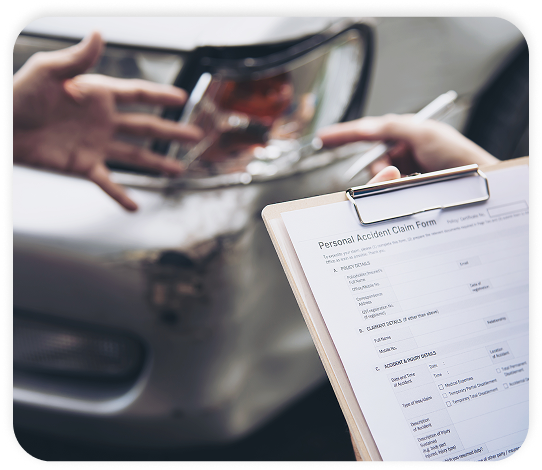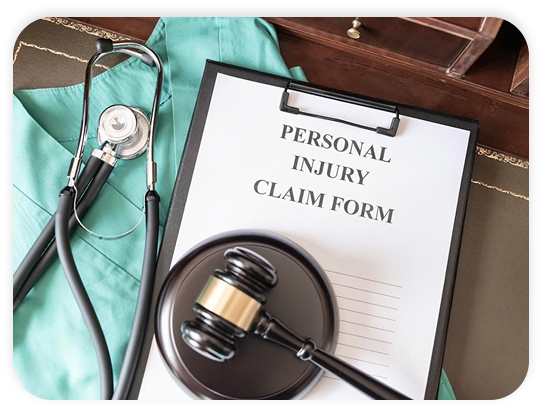The Ohio Personal Injury Legal Process
Clear, Ohio-specific guidance on what happens from crash to compensation – and how our attorneys protect your claim every step of the way.
Your Roadmap After an Ohio Crash
Get care & document injuries
Notify insurers (carefully)
We investigate & send a demand
Negotiate
Collect & resolve liens
Trial
Discovery & mediation
File suit if needed
Why this page matters
Ohio injury law has strict deadlines, damage caps, and special rules for claims involving government entities and transit agencies. Below is the same step-by-step process we use for clients in Columbus, Cleveland, Cincinnati, Dayton, Toledo, Akron, and across Ohio – with citations to current Ohio law.
Prefer to talk it through?
Step 1: Safety, Medical Care & Early Documentation
- Call 911 and make a report.
- Photograph vehicles Photograph vehicles, scenes, hazards, skid marks, and visible injuries.
- Identify witnesses and save names/phone numbers
- Seek medical care immediately - even for “minor” symptoms. Delays are commonly used to dispute causation.
- Start a file: medical records/bills, repair estimates, work notes for missed time, discharge instructions, and a simple pain journal.
Upload photos and bills securely:
Step 2: Insurance Notifications (Without Jeopardizing Your Claim)
- Notify your carrier promptly (policy cooperation), but do not give a recorded statement to the at-fault insurer before legal advice. We handle all communications and prepare a formal demand package when treatment stabilizes. See how demand letters work in Ohio.
Want us to deal with the adjuster?
Step 3: Liability & Damages Investigation
- Police and crash reports
- Photos, scene measurements, and any available traffic or onboard video
- Vehicle data, maintenance logs (for trucks, buses), and cell phone records when appropriate
- Medical records and expert opinions (treating physicians, accident reconstruction, life-care planners)
This evidence drives both settlement value and trial strategy.
Step 4: Settlement Demand & Negotiation
- When you’ve reached maximum medical improvement (MMI) or a physician outlines future care, we send a demand summarizing fault, injuries, economic losses, and non-economic harm (pain, suffering, loss of enjoyment). Ohio law places statutory limits on certain damages—details below. If the insurer negotiates in good faith, most cases resolve here.
See if your case is “demand-ready.”
Step 5: When a Lawsuit Becomes Necessary
- When you’ve reached maximum medical improvement (MMI) or a physician outlines future care, we send a demand summarizing fault, injuries, economic losses, and non-economic harm (pain, suffering, loss of enjoyment). Ohio law places statutory limits on certain damages—details below. If the insurer negotiates in good faith, most cases resolve here.
See if your case is “demand-ready.”
Ohio-Specific Rules That Affect Your Case Value
1) Comparative Negligence (the “51% bar”)
Ohio follows modified comparative negligence: your recovery is reduced by your percentage of fault, and barred entirely at 51% or more.
Example: if you’re 20% at fault, a $100,000 verdict becomes $80,000.
2) Caps on Non-Economic Damages
Ohio caps pain-and-suffering damages in most tort cases at the greater of $250,000 or 3× economic losses, with a per-plaintiff ceiling of $350,000 and $500,000 per occurrence—unless the injury qualifies as a catastrophic type (e.g., loss of limb, permanent and substantial deformity, loss of organ system), in which case the cap is lifted.
3) Punitive Damages
Punitive damages are generally capped at two times compensatory damages (with special rules for small employers/individuals). Courts require clear and convincing evidence of malice or egregious conduct.
4) Collateral Source & Subrogation
Ohio permits limited evidence of collateral benefits under R.C. 2315.20, but subrogation rights (e.g., health insurance, Medicare/Medicaid, ERISA) can bar such evidence and must be resolved from settlement proceeds. We handle lien audits and reductions.
Confused about caps and liens?
Special Situations in Ohio


-
Claims Against Cities, Counties & Public Transit (Sovereign Immunity):
Suing a political subdivision (e.g., city bus, unsafe roadway) triggers the Political Subdivision Tort Liability Act with immunities and narrow exceptions. Strategy and pleading matter. -
Claims Against the State of Ohio:
Claims against state agencies (including some transit/contractor situations) may belong in the Ohio Court of Claims and follow unique rules and fees (including a modest filing fee and possible poverty affidavit). We handle this process end-to-end. -
Practical note (Central Ohio):
Even routine damage claims against municipalities (e.g., potholes) are hard to win without proving negligence, not just “it happened.”
Was a city, county, or transit agency involved?
What Happens After We File Suit
- Pleadings & Scheduling
- Complaint & Answer filed; court issues a case schedule with deadlines.
- Early motions may challenge parts of the case
- Discovery (Fact-Finding)
- Written discovery: Interrogatories, document requests, requests for admission.
- Depositions: Sworn testimony of parties, witnesses, treating providers.
- Independent medical exams (IMEs) may be requested by the defense.
- Mediation & Settlement Conferences
- Most Ohio courts encourage mediation. A neutral mediator helps parties explore settlement—often after key depositions and medical reports.
- Pre-Trial Motions
- Motions may ask the court to exclude improper evidence or even grant judgment if facts aren’t disputed.
- Trial
- Jury selection → openings → witnesses → closings → verdict.
- Jury assigns fault percentages and awards damages within Ohio’s statutory framework (caps/comparative fault).
- Post-Verdict & Appeals
- The court enters judgment; parties may file post-trial motions or appeal.
- We pursue collection if the insurer/defendant doesn’t pay promptly.

How Long Does an Ohio Injury Case Take?
Every case is unique, but typical ranges:
What Compensation Can You Pursue?
- Traumatic brain injuries (TBI)
- Wrongful death damages for eligible family (different statute/rules)
- Punitive damages in egregious cases (caps apply)
- Lost wages & diminished earning capacity
- Non-economic losses: pain, suffering, loss of enjoyment (subject to caps)
- Property damage
Confused about caps and liens?
How Our Fee Works (No Upfront Cost)
We represent injured Ohioans on a contingency fee: no fee unless we recover money for you. We advance case costs (experts, records, filings) and are paid from the recovery—not out of your pocket. If there’s no recovery, you owe no attorney fee.
It’s risk-free to ask questions.
Common Questions About the Ohio Legal Process
How long do I have to file?
Generally two years from the injury date (special rules for minors, medical claims, wrongful death, and government defendants). Ask us to confirm your exact deadline.
What if I was partly at fault?
You can still recover if you’re 50% or less at fault; your award is reduced by your percentage. 51% or more bars recovery.
Do Ohio damage caps apply to my case?
Not necessarily. In most cases, we are able to negotiate a fair settlement with the insurance company without going to trial. However, if a fair agreement cannot be reached, our experienced trial lawyers will be prepared to take your case to court to fight for your rights.
Will I have to go to court?
Not necessarily. In most cases, we are able to negotiate a fair settlement with the insurance company without going to trial. However, if a fair agreement cannot be reached, our experienced trial lawyers will be prepared to take your case to court to fight for your rights.
What about my health-insurance/Medicare liens?
Not necessarily. In most cases, we are able to negotiate a fair settlement with the insurance company without going to trial. However, if a fair agreement cannot be reached, our experienced trial lawyers will be prepared to take your case to court to fight for your rights.
Can I sue a city or RTA bus?
Not necessarily. In most cases, we are able to negotiate a fair settlement with the insurance company without going to trial. However, if a fair agreement cannot be reached, our experienced trial lawyers will be prepared to take your case to court to fight for your rights.
What’s my role during the case?
Not necessarily. In most cases, we are able to negotiate a fair settlement with the insurance company without going to trial. However, if a fair agreement cannot be reached, our experienced trial lawyers will be prepared to take your case to court to fight for your rights.
A Realistic Timeline (Typical Ohio Case)
Get your personalized case plan:
What We Do So You Can Recover

Protect deadlines
and file in the right
court

Build liability
with expert-backed
evidence

Maximize damages
within Ohio’s statutory
framework

Negotiate
aggressively with insurers
and lienholders

Try cases
before Ohio juries when
necessary
“From day one, they handled the insurance company and I focused on getting better. The settlement covered my care and lost time.” — Recent Ohio client (name on file)
Ready to take the next step?
Contact Us for a Free
Consultation
Ready to discuss your case? Our team is available 24/7 to provide expert guidance and fight for the compensation you
deserve. Call us or fill out the form below to get started.
